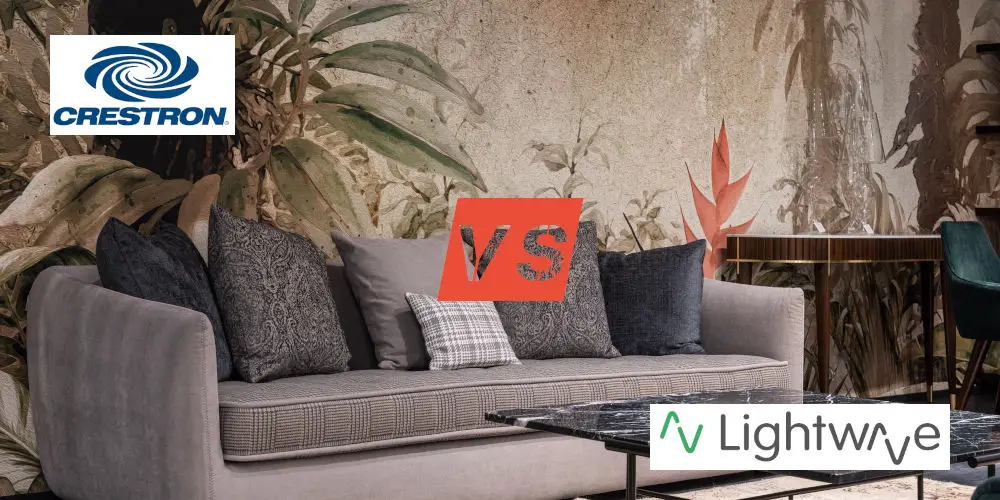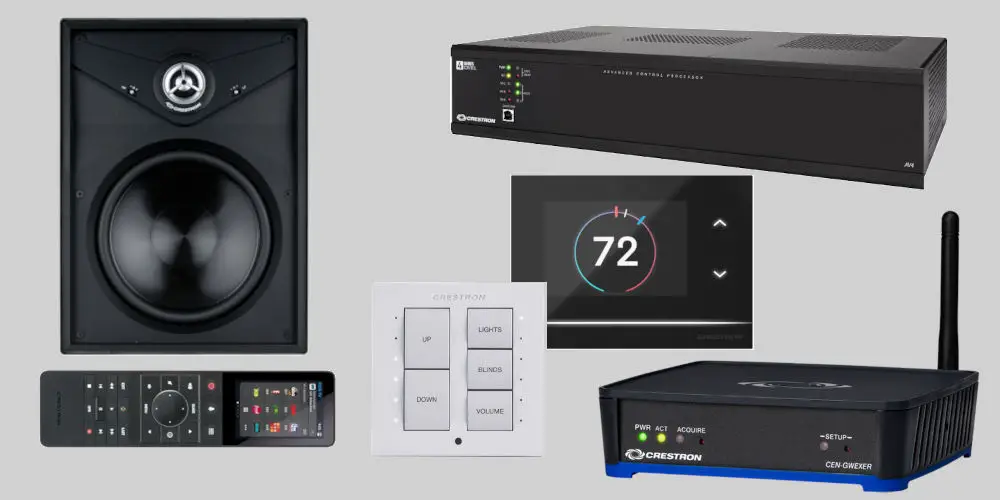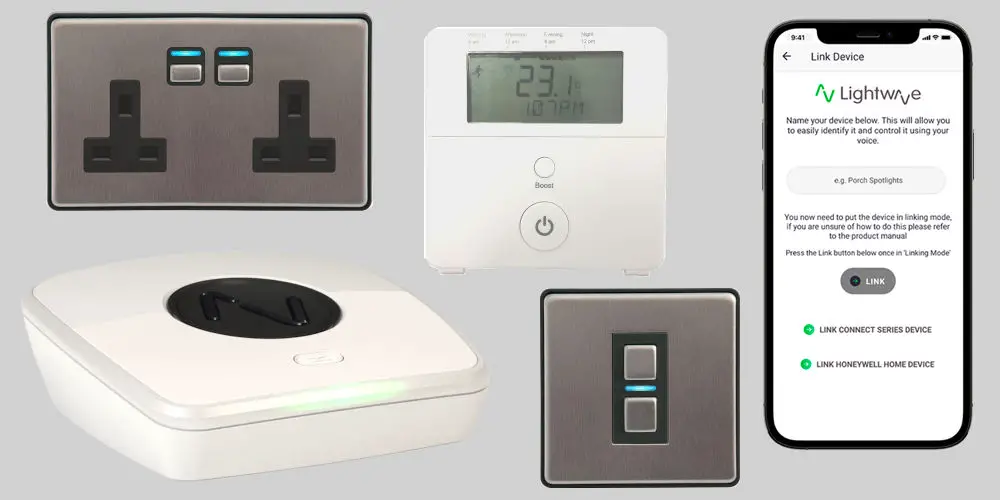Best option: Crestron vs Lightwave home automation?

Comparing Crestron vs Lightwave might seem weird, especially at first. Lightwave is an affordable, DIY smart home system, while Crestron is a professional-level automation system. Regardless of your budget, requirements and situation, it’s worth considering all possible solutions.
Comparing these smart home systems is interesting as they achieve similar basic outcomes but use completely different methodologies.
Available from a dealer network, Crestron is a wired system that’s complex to design, install and configure, hence the need to work with an approved dealer. Widely available, Lightwave is a DIY friendly solution that uses wireless technology and two-way communication.
Hopefully, from this brief outline, you can appreciate a few of the main differences between Lightwave and Crestron.
As we investigate each system in detail, we’ll scrutinise what makes them unique. We’ll then try to draw a fair comparison between the two systems. By the end, you’ll be able to make an informed decision when looking at using either Crestron vs Lightwave in your home.
Crestron home automation

photo by Crestron
History
Founded in 1971 by inventor and engineer George Feldstein, Crestron Electronics is one of the oldest home automation companies in the world. Based in New Jersey, USA, the company designs, manufactures, and distributes smart home and audiovisual equipment using a global dealer network.
Much like other high-end home automation systems, you can’t buy products directly from Crestron. Instead, they use a global network of dealers to design, install and configure automation systems.
There are many uses for Crestron home automation products, with luxury homes only being a small part of their business. They also supply the US government, Microsoft, hotels, hospitals and schools.
Crestron provides complete control of every element, both within the home and office. Easily operate lights, heating, gates, TVs and a home cinema room, both in person and remotely using Wi-Fi.
How does Crestron works?
Using a wired network, Crestron requires your home to be rewired. At the heart of the system is rack-mounted modules that control the system and devices are wired into these. That said, the majority of the controllers are battery-powered, wireless units.
Despite its wired network, integrating wireless devices, including Amazon Alexa, Sonos smart speakers, and Google Assistant into a system is effortless. These add-ons increase the number of functions the user can control.
Unless you know what your doing, installing and configuring Crestron devices isn’t possible. Hence the need to work with an approved highly trained dealer. That said, once installed, a Crestron system is rock solid.
One downside of having to buy devices using a dealer is they are free to set the price. That said, you might be able to negotiate a good deal by playing two dealers off each other! The buying experience is completely different from asking a local electrician to install a few smart sockets!
Each system is unique to the client, their home and their requirements. If you compared two homes that use a Crestron system, you’d quickly realise that each will act, look and feel differently.
Is it DIY friendly?
Designed for performance, not ease of installation, unless you’ve worked with Crestron devices before, you’ll want to hire a dealer. Of course, they aren’t cheap as they are highly trained and work with the Crestron ecosystem daily.
Many wrongly believe they can watch eBay for second-hand devices and try to cobble a system together. While devices occasionally appear on online marketplaces, you’d be waiting years for every device that you need to be available for sale.
You’ll, therefore, need to work with a dealer from conception to installation and configuration to ensure you have a system that aligns with your requirements.
Current product range
Crestron provides a range of products and solutions to build a fully automated home. They offer sophisticated lighting control, including options to program complex scenes and sequences, controllable by a single button.
Automate your blinds and curtains, so they close on cue whether you’re at home or away. Enjoy superior multi-room audio and video, thanks to Crestron DigitalMedia™ technology, and a range of switchers, amplifiers and speakers. Even Sonos products seamlessly integrate into the system.
The system offers flexible temperature control that uses data from multiple sensors placed around the property. Your home’s temperature will be constant, ensuring you are always warm.
Crestron provides a range of solutions to keep your home safe and secure. Secure your front door with a Yale lock and video intercom, and control your garage and gate using the system. You can even add a range of security cameras.
The current Crestron Home™ OS 3 delivers a simple, clean, and sophisticated user experience. Control your entire system from a single point using a touch screen, remote, keypad or the app.
Any downsides?
As your property need to be rewired as part of the installation process, Crestron isn’t designed for historic or listed buildings. Ideally, the system is best for new builds. As you might expect, running new cables around your home isn’t cheap, and labour costs can quickly add up.
Most homeowners spend £75,000 plus when adding a Crestron system. So, it’s hardly a system you would install on a whim or try to DIY. As you have to work with a dealer, it takes time to install and configure a system. You can’t get up and running overnight.
As devices are only available from dealers, Crestron devices are costly, and finding a price list can be tricky. Dealers don’t want to be knocked down on price or have clients trying to remove features to save money.
As new software and firmware updates become available, you’ll need to pay your dealer to send their engineer out to apply the latest updates as you can’t do this yourself.
Lightwave

photo by Lightwave
History
Since forming JSJS Designs in 2008, John Sinclair and John Shermer have transitioned from building home automation solutions for the disabled to releasing products for the general consumer market.
Before becoming Lightwave, they teamed up with B&Q to release the HomeEasy range. They also partnered with Siemens on a system that would become the basis for the first generation of LightwaveRF products. They’ve since dropped the RF and are simply known as Lightwave.
How Lightwave works
Using wireless low powered radio frequencies, Lightwave allows control over a range of household devices with an affordable price tag. While the basic technology is widely available, Lightwave uses a unique control protocol.
At the centre of the system is a hub that connects to your Wi-Fi router. The hub sends commands to devices and allows control over them using remotes, a website and an app.
While more than sufficient for most applications, it does not have the advanced features of a mesh network technology such as Z-Wave. But more on that later.
However, Lightwave addressed this shortfall by adding 2-way communication in its second generation (read more: Lightwave gen 1 vs 2 comparison), which results in a stronger network and wider range within the home. With the 2nd generation, you’re no longer limited to a range of 15 metres.
Is it DIY friendly?
If you’re good at DIY then there are virtually no installation costs and many products can be retrofitted. Unlike some home automation brands that require installation by an approved engineer, you should be up and running with Lightwave in a few hours.
The power sockets and lighting switches are easy to install and come in a range of cool finishes. Once installed, each device needs to be paired with the hub and the app. This is also really easy to do.
You can use Alexa and Google Assistant to control your smart home system, giving you greater flexibility.
Current products
Offering a limited product range, Lightwave provides all of the essentials you need to start automating your home. You can power sockets (single and dual gang) and lighting switches (single, double, triple, quad) as well as a heating system (TRV valve controls, boiler switch, thermostat).
They also offer doorbells, several sensors, and relays. Using Lightwave devices you can easily control your lights, heating, power, blinds and more. Plus the Lightwave app is easy to use and allows control over your smart home system from anywhere with Wi-Fi.
Downsides
Highly affordable, Lightwave does have quite a few limitations. First, the sockets are designed for the UK market, so aren’t widely available. They have released an EU style power socket, but are still far behind other smart home brands.
As Gen 1 devices can’t talk with each other, the hub has to tell each unit what to do, limiting the range to 15 metres indoors. The second-generation products solve some of these issues. Unfortunately, the two generations aren’t fully compatible with each other.
You’re limited to a total of 200 devices in a single Lightwave system. Each device can be paired with only 6 controllers or sensors. The device limit comes down to a lack of controller memory rather than the Lightwave technology itself.
Crestron vs Lightwave
So that’s a brief overview of each of the home automation systems. But which is better? Let’s compare Crestron vs Lightwave and see which is ideal for you.
Crestron
Only available from approved dealers, Crestron is a highly flexible system initially designed for commercial uses. To become a Crestron dealer, you have to complete extensive training to ensure the customer receives an unrivalled buying experience and support.
One of the benefits of buying a Crestron system is they rigorously test products before releasing them. They also evaluate numerous third party products using the same extensive process to ensure they work faultlessly with Crestron.
Using a wired network means the system doesn’t rely on Wi-Fi to operate. There is only a minimal risk of dropouts or connection issues. That said, many wireless devices work with the system, including the Crestron app that’s available for phones and tablets.
Arguably the biggest unique selling point is the dealer takes care of designing, installing and configuring the system. After agreeing on what devices the system controls, the dealer will manage the project until completion.
Of course, having someone else design, install and configure your system comes at a high price. It can also be quite expensive to keep a Crestron system up to date and running smoothly.
Lightwave
Lightwave, on the other hand, is very simple to use. You can buy a Lightwave starter kit for under £100, including one which uses a remote and plug-in power socket to enable basic control.
As a system, they have developed over the last few years with the introduction of the heating system and generation 2. Gen 2 offer many improvements, including two-way communication, automation scenes and a new hub that handles up to 200 devices.
The system also integrates with devices using IFTTT (if this then that), allowing you to easily trigger 3rd party devices and systems, including the Hive Active Heating system.
With all that said, it’s a closed system that’s still quite basic and only available in the UK. So if you’re looking for a simple and affordable way to automate the bulk of your home, then Lightwave is the system for you.

Picking a winner: Crestron vs Lightwave home automation system!
At first glance, Crestron and Lightwave achieve a similar basic outcome of automating your home and simplifying your life. However, each system uses a completely different logic and method. Crestron, while far more expensive is highly flexible and can control a wider range of devices.
If you’re starting on your smart home journey, Lightwave is a fantastic option. You can slowly build a home automation system that aligns with your requirement, budget and home. Plus, as a UK based company, Lightwave offers excellent customer support.
Installing Crestron in your home requires a large budget as you have to work with a dealer who will design, install and configure your system. For the best result, you should install the system in one go, so you’ll need to know what you’d like automated upfront.
That said, with Crestron as you work with a dealer, your involvement is minimal. Installing Lightwave means you’ll need to troubleshoot the system and may have to find your own solutions.
Another way to decide between them is to consider your property’s value. Lightwave is ideal for properties valued at under £750,000 or if you live in a historic building that would be difficult to rewire.
If your property is worth over £1,000,000, you’ll probably have the budget to install a Crestron system and may not have the time to install it yourself.
Hopefully, that gives you a clearer idea when choosing between Crestron vs Lightwave.




